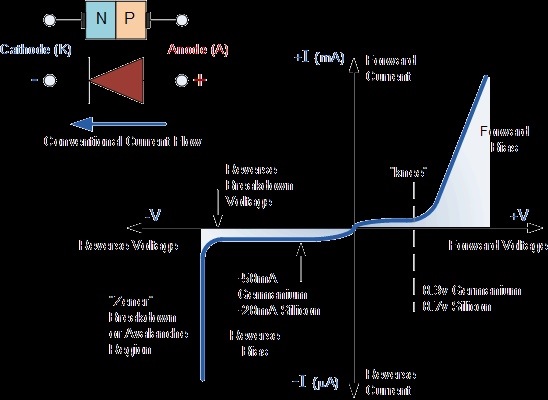The effect described in the previous tutorial is achieved without any external voltage being applied to the actual PN junction resulting in the junction being in a state of equilibrium. However, if we were to make electrical connections at the ends of both the N-type and the P-type materials and then connect them to a battery source, an additional energy source now exists to overcome the barrier resulting in free charges being able to cross the depletion region from one side to the other. The behaviour of the PN junction with regards to the potential barrier width produces an asymmetrical conducting two terminal device, better known as the Junction Diode.
A diode is one of the simplest semiconductor devices, which has the characteristic of passing current in one direction only. However, unlike a resistor, a diode does not behave linearly with respect to the applied voltage as the diode has an exponential I-V relationship and therefore we can not described its operation by simply using an equation such as Ohm’s law.
If a suitable positive voltage (forward bias) is applied between the two ends of the PN junction, it can supply free electrons and holes with the extra energy they require to cross the junction as the width of the depletion layer around the PN junction is decreased. By applying a negative voltage (reverse bias) results in the free charges being pulled away from the junction resulting in the depletion layer width being increased. This has the effect of increasing or decreasing the effective resistance of the junction itself allowing or blocking current flow through the diode.
Then the depletion layer widens with an increase in the application of a reverse voltage and narrows with an increase in the application of a forward voltage. This is due to the differences in the electrical properties on the two sides of the PN junction resulting in physical changes taking place. One of the results produces rectification as seen in the PN junction diodes static I-V (current-voltage) characteristics. Rectification is shown by an asymmetrical current flow when the polarity of bias voltage is altered as shown below.
 Junction Diode Symbol and Static I-V Characteristics.
Junction Diode Symbol and Static I-V Characteristics.
But before we can use the PN junction as a practical device or as a rectifying device we need to firstly bias the junction, ie connect a voltage potential across it. On the voltage axis above, “Reverse Bias” refers to an external voltage potential which increases the potential barrier. An external voltage which decreases the potential barrier is said to act in the “Forward Bias” direction.
There are two operating regions and three possible “biasing” conditions for the standard Junction Diode and these are:
1. Zero Bias – No external voltage potential is applied to the PN-junction.
2. Reverse Bias – The voltage potential is connected negative, (-ve) to the P-type material
and positive, (+ve) to the N-type material across the diode which has the effect of
Increasing the PN-junction width.
3. Forward Bias – The voltage potential is connected positive, (+ve) to the P-type material and
negative, (-ve) to the N-type material across the diode which has the effect of Decreasing the
PN-junction width.
Zero Biased Junction Diode
When a diode is connected in a Zero Bias condition, no external potential energy is applied to the PN junction. However if the diodes terminals are shorted together, a few holes (majority carriers) in the P-type material with enough energy to overcome the potential barrier will move across the junction against this barrier potential. This is known as the “Forward Current” and is referenced as IF.
Likewise, holes generated in the N-type material (minority carriers), find this situation favourable and move across the junction in the opposite direction. This is known as the “Reverse Current” and is referenced as IR. This transfer of electrons and holes back and forth across the PN junction is known as diffusion, as shown below.

